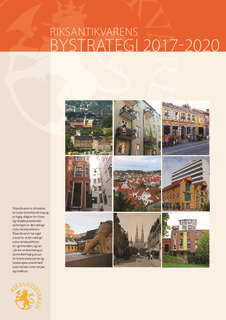The Directorate for Cultural Heritage is an Associate Partner for the Deep Cities project in Norway. Here, Special Advisor at the Directorate Marit Huuse writes about the importance developing our historic urban environments.

We live in a time of great and rapid change in our physical environment. In particular, cities are constantly changing. But the cities also have traces of history, through its streets, property structure, buildings and building environments. These are cultural heritage and cultural environments that help to give the city a distinctive character and uniqueness. Squares, marketplaces, and buildings of different ages provide an experience for both residents and visitors.
Cultural heritage and cultural environments enrich the peoples experience in a city and are also providers of knowledge. A lot of knowledge about past times lies precisely in these physical traces. Cultural heritage hints at the historical development, about people’s relationship to each other and to nature.
They tell about access to and use of resources, about businesses and people’s social, religious, and ritual lives. They testify to both continuity and change through the ages and are an important basis for our interpretation and understanding of the past.
Cultural heritage provide an opportunity for recognition and belonging, but also a curiosity, a thirst for knowledge, and an experience of closeness to the past. In addition, they can be an important identity-creating factor in that they contribute to the distinctiveness and character of places, through continuity, variation, contrast and character in the human-influenced environment.
The cultural heritage that the cities carry with them is important for the uniqueness of the places, but also for unity and belonging. The city’s historical and cultural content is also potentially valuable. It is a resource for visitors and for everyone who lives in the city, it creates attractive urban environments, and it provides a basis for tourism and business development.
What makes places attractive to visit – what do we look for when we travel? Very often it is the historical places because this gives character and experiences. Cultural heritage and cultural environments are common goods and resources for the local communities and represent great societal values. Conservation and use also contribute to socio-economic resource management.
The evolving nature of cities
At the same time, a city must function, meet needs, be a good framework for individuals and as a society need in everyday life. It must therefore constantly evolve. New stories and narratives are added to the city and the challenge is to at the same time take care of the important stories that are already there.
To take care of and utilize this, a planning and management practice is required that considers the cultural environment as a premise for development, but also as a resource and an opportunity. Cultural heritage’s positive opportunities in urban and local development, as well as its important contribution to sustainable development, must be emphasized.
It is a goal to ensure sustainable urban and community development. Preservation and use of the resources that the cultural environments represent in the cities is important in this context. And it is especially important from a climate and environmental perspective since most of the buildings of the future have already been built.
Preservation has major benefits for the climate
The most climate-friendly building is the one that is already there. The recent report from the research institute SINTEF “Green is not just a color – Sustainable buildings already exist”, show that it is almost always better to preserve and rehabilitate than to build new, especially in a scenario where we have to cut greenhouse gas emissions sharply over the next 30 years.
The study concludes that there is a large untapped potential for environmental benefits in the existing building stock. The environmental impact from existing buildings is only about half of that from new buildings. Since most of the world’s building stock by 2050 already exists, rehabilitation and reuse of existing buildings will be a crucial contribution to a sustainable future.
A strategy that contributes to taking care of older buildings has major climate benefits and will contribute to sustainable development. It is therefore important with national planning policy that aims to achieve sustainable management of the country’s total resources and to create a good physical environment.
Through my work at the Directorate for Cultural Heritage, I have been involved in developing the Directorate’s role in urban development matters. The Directorate is a professional adviser to the Ministry of Climate and the Environment in the development of the state’s cultural environment policy, at the same time as we are responsible for the implementation of the state’s cultural environment policy. We also have an overall professional responsibility for the municipalities ‘, county municipalities’ and Sami Parliament’s work with the cultural environment.
This means that we work in two ways. We are a professional body that works with the development of knowledge, tools, methods and is an advisor to other actors. But we are also an authority under the Cultural Heritage Act and the Planning and Building Act and must ensure that national cultural heritage values are safeguarded.

Directorate for Cultural Heritage
Through the development of the Directorate for Cultural Heritage’s urban strategy, we wanted to contribute to quality in urban development and to preserve and further develop our historic urban environments. Long-term and sustainable management of the historic urban environments presupposes that the buildings are used and maintained and that the historic building environments retain their distinctive character and are still perceived as attractive buildings and places to live.
New National Goals for the Cultural Environment
The new cultural environment Proposition to the Parliament (Meld. St.16 2019-2020), which was adopted in June, introduced new national goals for the cultural environment field with the themes of commitment, sustainability and diversity. These are goals that embrace more broadly and to a greater extent emphasize the importance of the cultural environment for society than the previous goals.
These are excellent goals, but at the same time challenging. The commitment goal is: Everyone should have the opportunity to get involved and take responsibility for the cultural environment. We know that people think cultural monuments and cultural environments are important and many get involved through voluntary organizations, among other things.
Many individuals and organizations make a huge effort to take care of the cultural environment in their immediate area. But how do we better facilitate more people to get involved, participate and participate? How do we facilitate that individuals and local communities can participate better in the work with cultural environments and be able to bring out what is important to them and their local communities.
What we need is a good framework for engagement, but also good methods and tools for participation and involvement. It is therefore exciting to be part of this project, which has as its main goal to develop a management tool to better understand how change can be handled in urban development where participation from the public is central.

Leave a Reply